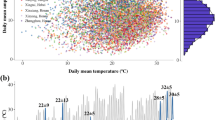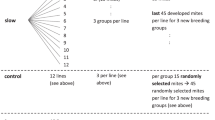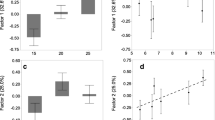Abstract
Rather than a true adaptive process, laboratory colonization is proposed to depend on the plasticity of the tolerance limits in insect species. Insects will establish successfully in captivity if the magnitude of environmental variables are within the insects’ ranges of colonization. Optimum physiological and behavioural responses are obtained when the variables are within the smaller preferred range of colonization. Other concomitant processes at colonization are selection, acclimatization and domestication. Definition of the terms “adaptation”, “acclimatization” and “domestication”, commonly misused in describing processes during laboratory colonization are proposed.
Résumé
La colonisation des insects depend de leur limite de tolerances au laboratoire mais pas au fait pas d’un vrai processus d’adaptation. Les insectes peuvent s’etablir en captivite; si les variables environnementales sont dans la limite acceptable. Les reponses physiologiques et du comportement optimale sont obtenues quand les variables sont pres des valeurs minimales de la colonisation — Les autres facteurs affectant la colonisation sont la selection, l’acclimatisation et la domestication. Les definitions desces mots sou vent mal interpretées pendant la colonisation des insectes au laboratoire sont proposees.
Similar content being viewed by others
References
Agee H. R. (1986) Laboratory-reared weevils (Coleoptera: Curculionidae) are visually impaired. J. Econ. Entomol. 79: 900–902.
Al-izzi A. J. M., Maliky S.A. and Jabbo N. F. (1987) Culturing the Carob moth, Ectomyelois ceratoniae (Zeller) (Lepidoptera: Pyralidae), on an artificial diet. J. Econ. Entomol. 80: 277–280.
Bartlett A.C. (1984a) Establishment and maintenance of insect colonies through genetic control. In Advances and Challenges in Insect Rearing (Edited by King E. G. and Leppla N. C.), Agricultural Research Service, USDA ARS Publishers, Washington.
Bartlett A. C. (1984b) Genetic changes during insect domestication. Ibid., pp. 2–8.
Bartlett A. C. (1985) Guidelines for genetic diversity in laboratory colony establishment and maintenance. In Handbook of Insect Rearing (Edited by Singh P. and Moore R. F.) vol. 1. pp. 7–17, Elsevier Science Publishers, Amsterdam.
Berlocher S. H. and Friedman S. (1981) Loss of genetic variation in laboratory colonies of Phormia regina. Entomol. Exp. & Appl. 30: 205–208.
Bernado R. J., Cupp E. W. and Kiszewski A. E. (1986) Rearing blackflies (Diptera: Simuliidae) in the laboratory: Colonization and life table statistics for Simulium vittatum. Ann. Entomol. Soc. Am. 79, 610–621.
Berry R. J. (1982) Neo-Darwinism. Institute of Biology’s Studies in Biology No. 144. Edward Arnold, London.
Boller E. F. (1972) Behavioral aspects of mass-rearing of insects. Entomophaga 17: 9–25.
Boller E. F. (1979) Behavioral aspects of quality in insectary production. In Genetics in Relation to Insect Management (Edited by Hoy M. A. and MacKelvey J. J.), pp. 153–160. Rockefeller Foundation, New York.
Boller E. F. and Chambers D. L. (1977) Quality aspects of mass-reared insects. In Biological Control by Augmentation of Natural Enemies (Edited by Ridgway R. L. and Vinson S. B.), pp. 219–235. Plenum Press, New York.
Brewer F. D. (1983) Evaluation of selected parameters as quality control criteria for mass producing a tobacco budworm (Lepidoptera: Noctuidae). Ann. Entomol. Soc. Am. 76: 339–342.
Bush G. L. (1975) Genetic variation in natural insect populations and its bearing in mass rearing programmes. In Controlling Fruit Flies by the Sterile Insect Technique. International Atomic Energy Agency (IAEA-PL-582/2) Vienna pp. 9–17.
Bush G. L. and Neck R. W. (1976) Ecological genetics of the screwworm fly, Cochliomya hominivorax (Diptera: Calliphoridae), and its bearing on the quality control of mass-reared insects. Environ. Entomol. 5: 821–826.
Bush G. L. (1979) Ecological genetics and quality control. In Genetics in Relation to Insect Management (Edited by Hoy M. A. and McKelvey Jr. J. J.), pp. 145–160. Rockefeller Foundation, New York.
Curtis C. F. (1985) Genetic control of insect pests: growth industry or lead balloon? Biol. J. Linnean Soc. 26: 359–374.
Dobzhansky T. (1941) Genetics and the Origin of Species. Columbia University Press, New York.
Dobzhansky T. (1970) Genetics of the Evolutionary Process. Columbia University Press, New York.
Economopoulos A. P. and Loukas M. (1986) ADH allele frequency changes in olive fruit flies shift from olives to artificial larval food and vice versa, effect of temperature. Entomol. Exp. Appl. 40: 215–221.
Edwards K. J. R. (1977) Evolution in Modern Biology. Institute of Biology’s Studies in Biology No. 7, Edward Arnold, London.
Gast R. T. (1968) Mass rearing of insects: Its concept, methods, and problems. In Radiation, Radioisotopes and Rearing Methods in the Control of Insect Pests. IAEA Panel Proceeding Series, IAEA Vienna.
Gould S. J. and Lewontin R. C. (1979) The spandrels of San Marco and the panglossian paradigm: A critique of the adaptationist programme. Proc. R. Soc. Lond. B, 205: 581–598.
Haefner J. W. (1970) The effect of low dissolved oxygen concentrations on temperature-salinity tolerance of the sand shrimp Crangon septemspinosa. Physiol. Zool. 43: 30–37.
Hobson J. M. and Singh P. (1987) Laboratory colonization of Planotortrix excessana on artificial diet. NZ J. Zool. 14: 81–83.
Hoffman K. H. (1985) Metabolic and enzyme adaptation to temperature. In Environmental Physiology and Biochemistry of Insects (Edited by Hoffman K. H.), pp. 1–32. Springer-Verlag, Berlin.
Joslyn D. J. (1984) Maintenance of genetic variability in reared insects. In Advances and Challenges in Insect Rearing (Edited by King E. G. and Leppla N. C.), pp. 20–29. Agricultural Research Service, USDA ARS Publishers, Washington.
Knippling E. F. (1982) Present status and future trends of the SIT approach to the control of arthropod pests. In Sterile Insect Technique and Radiation in Insect Control, International Atomic Energy Agency, (IAEA-SM-255/l)Vienna, pp. 3–23.
Knippling E. F. (1984) What colonization of insects means to research and pest management. In Advances and Challenges in Insect Rearing. (Edited by King E. G. and Leppla N. C.) pp. ix–xi. Agricultural Research Service, USDA ARS Publishers, Washington.
Koyama J., Nakamori H. and Kuba H. (1986) Mating behaviour of wild and mass-reared strains of the melon fly, Dacus curcurbitae Coquillet (Diptera: Tephritidae) in a field cage. App. Entomol. Zool. 21: 203–209.
Leppla N. C., Huettel M. D., Chambers D. L. and Turner W. K. (1976) Comparative life history and respiratory activity of “wild” and colonized Carribbean fruit flies (Dipt.: Tephritidae). Entomophaga 21: 353–357.
Leppla N. C., Guy R. H., Chambers D. L. and Workman R. B. (1980) Laboratory colonization of a noctuid moth. Ann. Entomol. Soc. Am. 73: 568–571.
Leppla N. C., Huettel M. D., Chambers D. L., Ashley T. R., Miyashita D. H., Wong T. T. Y. and Harris E. J. (1983) Strategies for the colonization and maintenance of the Mediterranean fruit fly. Ent. Exp. & Appl. 33: 89–96.
Lewontin R. C. (1965) Selection for colonizing ability. In The Genetics of Colonizing Species (Edited by Baker H. G. and Stebbins G. L.), pp. 77–94. Academic Press, New York.
Lewontin R. C. (1974) The Genetic Basis of Evolutionary Change. Columbia University Press, New York.
Lewontin R. C. (1978) Adaptation. Am. Sci. 239: 156–169.
Loukas M., Economopoulos A. P., Zouros E. and Vergin Y. (1985) Genetic changes in artificially reared colonies of the olive fruit fly (Diptera: Tephritidae). Ann. Entomol. Soc. Am. 78: 159–165.
Mackauer M. (1980) Some aspects of quality and quality control of biological control agents during insectary propagation. In Proceedings of V Int. Symposium on Biological Control of Weeds, pp. 207–220. Brisbane, Australia.
Mason L. J., Pashley D. P. and Johnson S. J. (1987) The laboratory as an altered habitat: Phenotypic and genetic consequences of colonization. Florida Entomol. 70: 49–58.
Mayr E. (1963) Animal Species and Evolution. Belknap Press, Cambridge, Mass.
Moore R. F. (1984) Message from the conference chairman. In Advances and Challenges in Insect Rearing (Edited by King E. G. and Leppla N. C.), pp. vii–viii. Agricultural Research Service, USDA ARS Publishers, Washington.
Moore R. F. (1987) Adaptation of the boll weevil to laboratory rearing on a soybean-Pharmamedia based diet. J. Agric. Entomol. 4: 29–32.
Nei M., Maruyama T. and Chakraborty R. (1975) The bottleneck effect and genetic variability in populations. Evolution 29: 1–10.
Ochieng’-Odero J. P. R. and Singh P. (1992) Life cycle changes during 12 successive generations of laboratory colonisation of the leafroller Cnephasia jactatana (Walker) (Lepidoptera, Tortricidae) on artificial diet. NZ J. Zool. 19: 113–121.
Pashley D. P. and Proverbs M. D. (1981) Quality control by electrophoretic monitoring in a laboratory colony of codling moths. Ann. Entomol. Soc. Am. 74: 20–23.
Proshold F. I. and Bartel J. A. (1972) Differences in radiosensitivity of two colonies of tobacco budworm, Heliothis virescens (Lepidoptera: Noctuidae). Can. Entomol. 104: 995–1002.
Putman R. J. (1984) The geography of animal communities. In Themes in Biogeography (Edited by Taylor J. A.), pp. 163–190. Croom Helm, London.
Putman R. J. and Wratten S. D. (1984) Principles of Ecology. Croom Helm, London.
Rai K. S. (1969) Status of the sterile-male technique for mosquito control. In Sterile-male Technique for Eradication or Control of Harmful Insects. IAEA Proceeding Series, Vienna.
Raulston J. R. (1975) Tobacco budworm: Observations on the laboratory adaptation of a wild strain. Ann. Entomol. Soc. Am. 68: 139–142.
Rossler Y. (1975) The ability to inseminate: A comparison between laboratory-reared and field populations of the Mediterranean fruit fly, Ceratitis capitata. Entomol. Exp. & Appl. 18: 255–260.
Roush R. T. (1986) Inbreeding depression and laboratory adaptation in Heliothis virescens (Lepidoptera: Noctuidae). Ann. Entomol. Soc. Am. 79: 583–587.
Ryan B. F., Joiner B. L. and Ryan Jr., T. A. (1985) Minitab Handbk. Duxbury Press, Boston.
Shelford V. E. (1913) Animal Communities in Temperate America. University of Chicago Press, Chicago, USA.
Schoonhoven L. M. (1967) Loss of hostplant specificity by Manduca sexta after rearing on an artificial diet. Entomol. Exp. & Appl. 10: 270–272.
Simpson G. W. (1953) The Major Features of Evolution. Columbia University Press, New York.
Singh P. (1983) A general purpose laboratory diet mixture for rearing insects. Insect Sci. Applic. 4: 357–362.
Singh P., Clare G. K. and Ashby M. D. (1985) Epiphyas postivittana. In Handbook of Insect Rearing (Edited by Singh P. and Moore R. F.), Vol. II. pp. 271–282, Elsevier Science Publishers, Amsterdam.
Smith P. H. and Morton R. (1985) Assessment of the field performance of compound chromosome strains compared to laboratory-reared wild-type strains in Lucilia cuprina (Wiedemann) (Diptera: Calliphoridae). Bull. Entomol. Res. 75: 233–244.
Steven D. (1988) Entomology and Kiwifruit. In Kiwi fruit: Science and Management (Edited by Warrington I. J. and Weston G. C.), Ray Richard Publisher and NZ. Soc. Hort Sci., Auckland.
Stock M. W. and Robertson J. L. (1982) Quality assessment and control in a western spruce budworm laboratory colony. Entomol. Exp. & Appl. 32: 28–32.
Tignor K. R. and Eaton J. L. (1986) Effects of prolonged colonization, crowding and starvation on development and survival rates of cabbage loopers, Trichoplusia ni (Hubner) (Lepidoptera: Noctuidae). Entomol. Sci. 21: 68–82.
van Lenteren J. C. (1986) Parasitoids in the greenhouse: Success with seasonal inoculative release systems. In Insect Parasitoids. pp. 341–374. Academic Press, London.
Author information
Authors and Affiliations
Rights and permissions
About this article
Cite this article
Ochieng’-Odero, J.P.R. Does Adaptation Occur in Insect Rearing Systems, or is it A Case of Selection, Acclimatization and Domestication?. Int J Trop Insect Sci 15, 1–7 (1994). https://doi.org/10.1017/S1742758400016696
Received:
Revised:
Published:
Issue Date:
DOI: https://doi.org/10.1017/S1742758400016696




